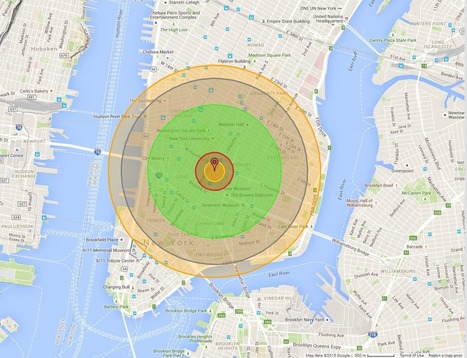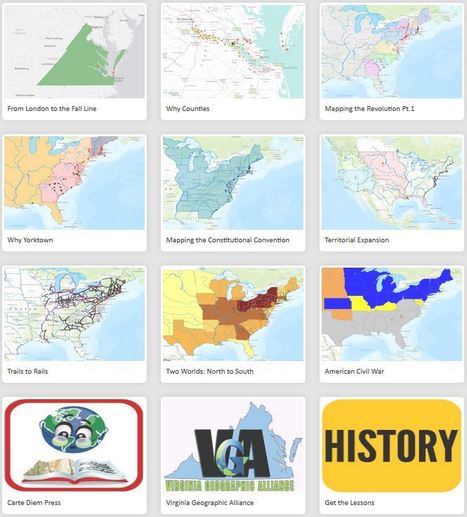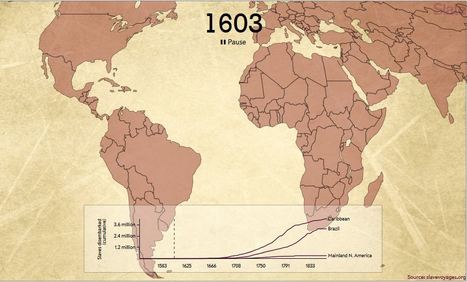 Your new post is loading...

|
Scooped by
Seth Dixon
|
We are very proud and honored for HSTRY to have been recognized as one of the top resources for education in 2015 by the American Association of School Librarians. We are furthermore delighted to have been recognized as a top resource for Curriculum collaboration. This emphasizes the versatility of our tool and how we are used by all kinds of subjects outside of the social studies scope.

|
Scooped by
Seth Dixon
|
"A new generation of scholarship has changed the way that the public understands American history, particularly slavery, capitalism, and the Civil War. Our language should change as well. The old labels and terms handed down to us from the conservative scholars of the early to mid-20th century no longer reflect the best evidence and arguments. Terms like 'compromise' or 'plantation' served either to reassure worried Americans in a Cold War world, or uphold a white supremacist, sexist interpretation of the past.Legal historian Paul Finkelman has made a compelling case against the label 'compromise' to describe the legislative packages that avoided disunion in the antebellum era."

|
Scooped by
Seth Dixon
|
"Maps bring the horror of Hiroshima home -- literally. Alex Wellerstein, a nuclear historian at the Stevens Institute of Technology, created a NukeMap that allows you to visualize what the Hiroshima and Nagasaki explosions would look like in your hometown. Kuang Keng Kuek Ser at Public Radio International has also developed a version, using slightly different estimates. Here is what Little Boy, the Hiroshima bomb, would look like on Wellerstein's map if detonated in New York City."

|
Scooped by
Seth Dixon
|
History is the polemics of the victor, William F. Buckley allegedly said. Not so in the United States, at least not regarding the Civil War. As soon as Confederates laid down their arms, some picked up their pens and began to distort what they had done, and why. Their resulting mythology went national a generation later and persists — which is why a presidential candidate can suggest that slavery was somehow pro-family, and the public believes that the war was mainly fought over states’ rights.
The Confederates won with the pen (and the noose) what they could not win on the battlefield: the cause of white supremacy and the dominant understanding of what the war was all about. We are still digging ourselves out from under the misinformation that they spread, which has manifested in both our history books and our public monuments.

|
Scooped by
Seth Dixon
|

|
Scooped by
Seth Dixon
|

|
Scooped by
Seth Dixon
|
On December 1, 1955, a 42-year old African American woman finished her job as a seamstress in a department store in Montgomery, Alabama. She waited to board the Cleveland Avenue city bus that, alth...
Tags: podcast, Maps 101, historical.

|
Scooped by
Seth Dixon
|
A rare exhibition at New York's Museum of Modern Art features 60 of Lawrence's paintings about the journey of 6 million African-Americans, who fled the segregated South during the Great Migration.
That mass exodus of African-Americans began a hundred years ago, and lasted until the 1970s. New York's Museum of Modern Art is honoring that history by displaying Lawrence's entire series for the first time since 2008, when it was shown at The Phillips Collection in Washington, D.C. Co-owned by the two museums, the paintings are making a rare appearance together now at MoMA in "One-Way Ticket: Jacob Lawrence's Migration Series and Other Visions of the Great Movement North."

|
Scooped by
Seth Dixon
|
has been pivotNot just tasty but essential for life, salt has a long and tumultuous history all its own.
You wouldn’t think it to look at them, but your salt and pepper shakers have caused a lot of problems over the years. Underneath that innocuous ceramic bulb lies a history of kingdoms torn apart, newly discovered worlds and powerful trade dynasties. The story of spices fills many a book, but we’re going to take an abridged look at salt and pepper over the next two weeks. Salt doesn’t just make your food tastier—it’s actually required for life. Sodium ions help the body perform a number of basic tasks, including maintaining the fluid in blood cells and helping the small intestine absorb nutrients. We can’t make salt in our own bodies, so humans have always had to look to their environments to fill the need. Early hunters could get a steady supply of salt from meat, but agricultural groups had to seek it out by following animal tracks to salt deposits.

|
Scooped by
Seth Dixon
|
So many textbooks overlook Ireland's Great Hunger and the Irish American story.

|
Scooped by
Seth Dixon
|
Single-perspective narratives do students a gross disservice.

|
Scooped by
Seth Dixon
|
Going after Advanced Placement History because it doesn’t teach “American Exceptionalism” is anything but patriotic
|

|
Scooped by
Seth Dixon
|
"I cannot deny people's grief," writes the host of the radio show The Takeaway, who works not that far from Ground Zero. "But I think the 9/11-ization of American life has been a kind of poison for all of us."

|
Scooped by
Seth Dixon
|
Armed with a Google search and a theory, a 14-year-old enters the fray on a longstanding historical debate
To her surprise, she got results. The Washington Post's Moriah Balingkit reports that newspaper archive databases turned up dozens of work ads from the 1800s with the “No Irish Need Apply” caveat spanning a number of professions and U.S. states. According to Fried's findings, which were published last month in the Journal of Social History, the New York Sun newspaper ran 15 “No Irish Need Apply” ads in 1842 alone.

|
Scooped by
Seth Dixon
|
Everything's bigger in Texas — including the gap between reality and what state officials want their kids to learn in school, apparently.
The Washington Post reported over the weekend that Texas' new social studies textbooks will not mention, A) Jim Crow laws, B) the Ku Klux Klan or C) the primary role slavery played in launching the U.S. Civil War.
Besides relegating generations of Texas kids to "most exasperating dinner guest imaginable" status, this move all but guarantees the ongoing misrepresentation of what the Civil War and, by extension, the Confederate flag were really about.

|
Scooped by
Seth Dixon
|
This interactive, designed and built by Slate’s Andrew Kahn, gives you a sense of the scale of the trans-Atlantic slave trade across time, as well as the flow of transport and eventual destinations. The dots—which represent individual slave ships—also correspond to the size of each voyage. The larger the dot, the more enslaved people on board. And if you pause the map and click on a dot, you’ll learn about the ship’s flag—was it British? Portuguese? French?—its origin point, its destination, and its history in the slave trade. The interactive animates more than 20,000 voyages cataloged in the Trans-Atlantic Slave Trade Database.

|
Scooped by
Seth Dixon
|
"We have a myth today that the ghettos in metropolitan areas around the country are what the Supreme Court calls 'de-facto' — just the accident of the fact that people have not enough income to move into middle class neighborhoods or because real estate agents steered black and white families to different neighborhoods or because there was white flight. It was not the unintended effect of benign policies, it was an explicit, racially purposeful policy that was pursued at all levels of government, and that's the reason we have these ghettos today and we are reaping the fruits of those policies."
Tags: economic, race, racism, historical, neighborhood, podcast, urban, place, poverty, socioeconomic.

|
Scooped by
Seth Dixon
|
From ancient India to the computer age, the military has used chess as both a metaphor and even as training for warfare.
There is nothing more dangerous - or deafening - than warfare. And there are few pursuits that are as safe and as quiet as chess. Yet chess began in 6th Century India as a 64-square board game, called Chaturanga, precisely modelled on the military forces of the day. There were "elephants", "chariots" and "'infantrymen".

|
Scooped by
Seth Dixon
|
A two-euro coin commemorating the bicentennial of Napoleon Bonaparte's defeat will not be widely released, after France objected to what it called a "negative symbol."

|
Scooped by
Seth Dixon
|
Early in April 1919 news of the arrest of Indian nationalist leaders in the Sikh holy city of Amritsar sparked riots in which a mob went on the rampage, killing several Europeans, leaving an English female missionary for dead, and looting numerous banks and public buildings. British and Indian troops under the command of Brigadier-General Reginald Dyer were sent to restore order and Dyer banned all public meetings which, he announced, would be dispersed by force if necessary.
Despite this, thousands gathered in protest in a walled enclosure called the Jallianwala Bagh, near the city’s Golden Temple, sacred to Sikhs. Dyer marched a force of 90 Gurkha and Indian soldiers into the enclosure and, without warning, they opened fire for about 10 to 15 minutes on the panicking crowd trapped in the enclosure. According to an official figure, 379 were killed and some 1,200 wounded, though other estimates suggest much higher casualties.

|
Scooped by
Seth Dixon
|
Women On 20s aims to compel historic change by convincing President Obama that NOW is the time to put a woman's face on our paper currency. But who should it be? We believe that's for you, the public, to decide from a slate of inspiring American women heroes.

|
Scooped by
Seth Dixon
|
“We tell our students about change over time, we have our students read about change over time, with GIS my students are able to see change over time”.
- Teresa Goodin, Gifted Resource Teacher, Albemarle County Schools
- Do you want your students to work like twenty-first century “digital” historians?
- Do you aim to have your students grasp the connections between geography and history?
- Do you aim to make your activities inquiry-based, interactive, and exciting?
- Do you aim to create activities that integrate twenty-first century workforce skills?

|
Scooped by
Seth Dixon
|
"Imagine you are a slave. You belong to a farmer who owns a tobacco plantation on the eastern shore of Maryland. Six long days a week you tend his field. But not for much longer . . .What will you do? Make your choices well as you embark on your journey to freedom. To play The Underground Railroad: Journey to Freedom, you must download and install the free Sandstone Player Software on your computer. Sandstone is required to support the 3-D style interaction in the game. Click here to find instructions for downloading Sandstone on a Mac or PC. The game is also available as both an iOS and an android app."
Tags: USA, historical, National Geographic.

|
Scooped by
Seth Dixon
|
Blacks weren’t the only victims of violence by white mobs.
While there are certainly instances in the history of the American South where law officers colluded in mob action, the level of engagement by local and state authorities in the reaction to the Plan de San Diego was remarkable. The lynchings persisted into the 1920s, eventually declining largely because of pressure from the Mexican government. Historians have often ascribed to the South a distinctiveness that has set it apart from the rest of the United States. In so doing, they have created the impression of a peculiarly benighted region plagued by unparalleled levels of racial violence. The story of mob violence against Mexicans in the Southwest compels us to rethink the history of lynching.
|
 Your new post is loading...
Your new post is loading...












































